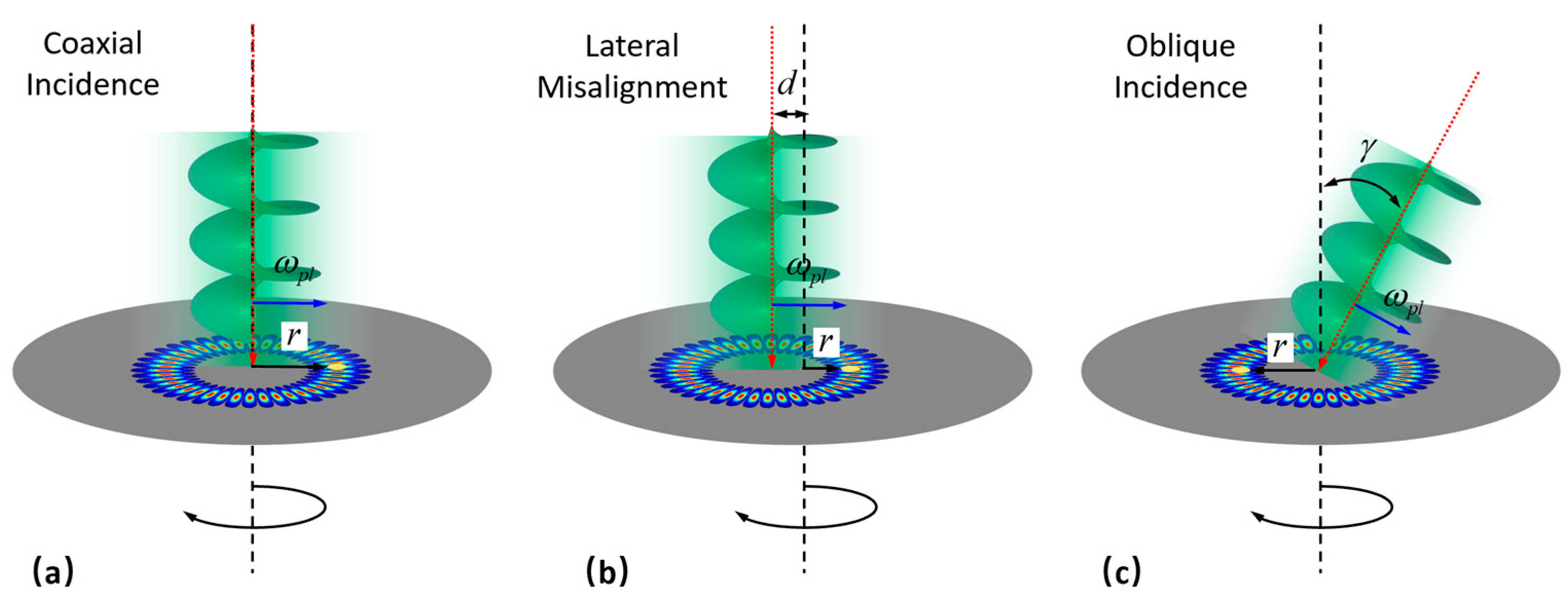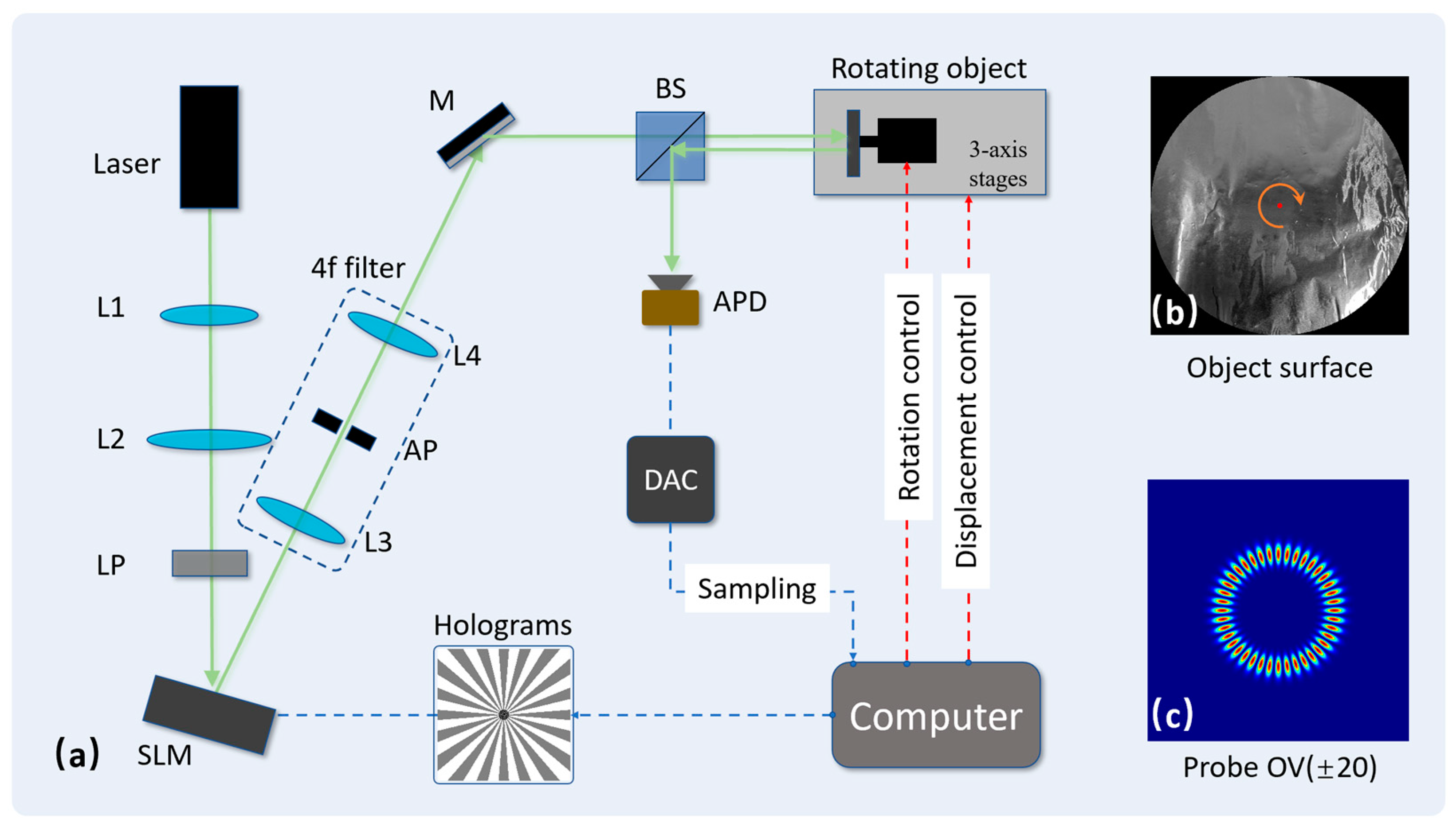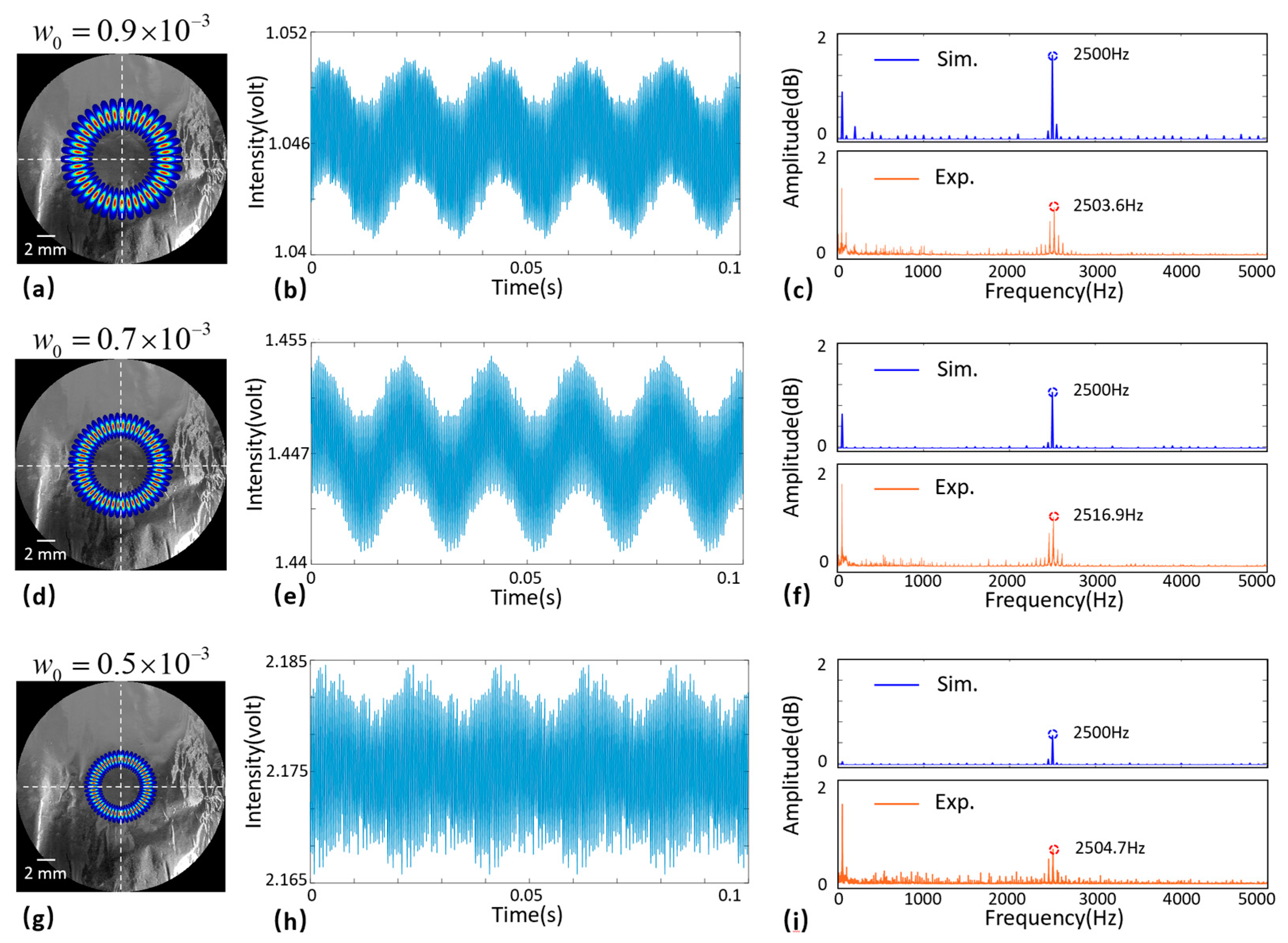Detection of a Spinning Object at Different Beam Sizes Based on the Optical Rotational Doppler Effect
Abstract
1. Introduction
2. Concept and Principles
3. Results
3.1. Experimental Setup
3.2. Results and Discussions
4. Discussion and Conclusions
Author Contributions
Funding
Institutional Review Board Statement
Informed Consent Statement
Data Availability Statement
Conflicts of Interest
References
- Censor, D. Theory of the Doppler effect: Fact, fiction and approximation. Radio Sci. 1984, 19, 1027–1040. [Google Scholar] [CrossRef]
- Lavery, M.P.J.; Speirits, F.; Barnett, S.M.; Padgett, M.J. Detection of a spinning object using light’s orbital angular momentum. Science 2013, 341, 537–540. [Google Scholar] [CrossRef] [PubMed]
- Lavery, M.P.J.; Barnett, S.; Speirits, F.; Padgett, M. Observation of the rotational Doppler shift of a white-light, orbital-angular-momentum-carrying beam backscattered from a rotating body. Optica 2014, 1, 1–4. [Google Scholar] [CrossRef]
- Seghilani, M.; Myara, M.; Sagnes, I.; Chomet, B.; Bendoula, R.; Garnache, A. Self-mixing in low-noise semiconductor vortex laser: Detection of a rotational Doppler shift in backscattered light. Opt. Lett. 2015, 40, 5778–5781. [Google Scholar] [CrossRef]
- Li, G.; Zentgraf, T.; Zhang, S. Rotational Doppler effect in nonlinear optics. Nat. Phys. 2016, 12, 736–740. [Google Scholar] [CrossRef]
- Fang, L.; Padgett, M.; Wang, J. Sharing a common origin between the rotational and linear Doppler effects. Laser Photonics Rev. 2017, 11, 1700183. [Google Scholar] [CrossRef]
- Zhang, W.; Gao, J.; Zhang, D.; He, Y.; Xu, T.; Fickler, R.; Chen, L. free-space remote sensing of rotation at the photon-counting level. Phys. Rev. Appl. 2018, 10, 044014. [Google Scholar] [CrossRef]
- Hu, X.-B.; Zhao, B.; Zhu, Z.-H.; Gao, W.; Rosales-Guzmán, C. In situ detection of a cooperative target’s longitudinal and angular speed using structured light. Opt. Lett. 2019, 44, 3070–3073. [Google Scholar] [CrossRef]
- Qiu, S.; Ren, Y.; Liu, T.; Chen, L.; Wang, C.; Li, Z.; Shao, Q. Spinning object detection based on perfect optical vortex. Opt. Lasers Eng. 2020, 124, 105842. [Google Scholar] [CrossRef]
- Guo, Z.; Meng, J.; An, M.; Cheng, P.; Jia, J.; Chang, Z.; Wang, X.; Zhang, P. Remote angular velocity measurement by the cascaded rotational Doppler effect. Appl. Opt. 2021, 60, 9892–9895. [Google Scholar] [CrossRef]
- Garetz, B.A. Angular Doppler effect. J. Opt. Soc. Am. 1981, 71, 609–611. [Google Scholar] [CrossRef]
- Allen, L.; Beijersbergen, M.W.; Spreeuw, R.J.C.; Woerdman, J.P. Orbital angular momentum of light and the transformation of Laguerre-Gaussian laser modes. Phys. Rev. A 1992, 45, 8185–8189. [Google Scholar] [CrossRef] [PubMed]
- Allen, L.; Babiker, M.; Power, W. Azimuthal doppler shift in light beams with orbital angular momentum. Opt. Commun. 1994, 112, 141–144. [Google Scholar] [CrossRef]
- Bialynicki-Birula, I.; Bialynicka-Birula, Z. Rotational frequency shift. Phys. Rev. Lett. 1997, 78, 2539–2542. [Google Scholar] [CrossRef]
- Phillips, D.B.; Lee, M.P.; Speirits, F.; Barnett, S.; Simpson, S.H.; Lavery, M.; Padgett, M.; Gibson, G.M. Rotational Doppler velocimetry to probe the angular velocity of spinning microparticles. Phys. Rev. A 2014, 90, 011801. [Google Scholar] [CrossRef]
- Rosales-Guzmán, C.; Hermosa, N.; Belmonte, A.; Torres, J.P. Direction-sensitive transverse velocity measurement by phase-modulated structured light beams. Opt. Lett. 2014, 39, 5415–5418. [Google Scholar] [CrossRef][Green Version]
- Zhai, Y.; Fu, S.; Yin, C.; Zhou, H.; Gao, C. Detection of angular acceleration based on optical rotational Doppler effect. Opt. Express 2019, 27, 15518–15527. [Google Scholar] [CrossRef]
- Ren, Y.; Qiu, S.; Liu, T.; Liu, Z. Compound motion detection based on OAM interferometry. Nanophotonics 2022, 11, 1127–1135. [Google Scholar] [CrossRef]
- Ma, H.; Li, X.; Tai, Y.; Li, H.; Wang, J.; Tang, M.; Wang, Y.; Tang, J.; Nie, Z. In situ measurement of the topological charge of a perfect vortex using the phase shift method. Opt. Lett. 2017, 42, 135–138. [Google Scholar] [CrossRef]
- Ma, H.; Li, X.; Zhang, H.; Tang, J.; Li, H.; Tang, M.; Wang, J.; Cai, Y. Optical vortex shaping via a phase jump factor. Opt. Lett. 2019, 44, 1379–1382. [Google Scholar] [CrossRef]
- Wang, C.; Ren, Y.; Liu, T.; Luo, C.; Qiu, S.; Li, Z.; Wu, H. Generation and measurement of high-order optical vortices by using the cross phase. Appl. Opt. 2020, 59, 4040–4047. [Google Scholar] [CrossRef] [PubMed]
- Yao, A.M.; Padgett, M.J. Orbital angular momentum: Origins, behavior and applications. Adv. Opt. Photonics 2011, 3, 161–204. [Google Scholar] [CrossRef]
- Vasnetsov, M.; Pas’Ko, V.A.; Soskin, M. Analysis of orbital angular momentum of a misaligned optical beam. New J. Phys. 2005, 7, 46. [Google Scholar] [CrossRef]
- Qiu, S.; Ding, Y.; Liu, T.; Liu, Z.; Ren, Y. Rotational object detection at noncoaxial light incidence based on the rotational Doppler effect. Opt. Express 2022, 30, 20441–20450. [Google Scholar] [CrossRef]
- Qiu, S.; Liu, T.; Ren, Y.; Li, Z.; Wang, C.; Shao, Q. Detection of spinning objects at oblique light incidence using the optical rotational Doppler effect. Opt. Express 2019, 27, 24781–24792. [Google Scholar] [CrossRef]
- Bekshaev, A.Y.; Soskin, M.S.; Vasnetsov, M.V. Rotation of arbitrary optical image and the rotational Doppler effect. Ukr. J. Phys. 2004, 49, 490–495. [Google Scholar]
- Qiu, S.; Liu, T.; Ding, Y.; Liu, Z.; Chen, L.; Ren, Y. Rotational Doppler effect with vortex beams: Fundamental mechanism and technical progress. Front. Phys. 2022, 10, 938593. [Google Scholar] [CrossRef]
- Allen, L.; Padgett, M. The Poynting vector in Laguerre–Gaussian beams and the interpretation of their angular momentum density. Opt. Commun. 2000, 184, 67–71. [Google Scholar] [CrossRef]
- Qiu, S.; Ren, Y.; Liu, T.; Li, Z.; Liu, Z.; Wang, C.; Ding, Y.; Sha, Q. Rotational Doppler effect detection by LG beams with a nonzero radial index. Opt. Express 2021, 29, 10275–10284. [Google Scholar] [CrossRef]
- Qiu, S.; Liu, T.; Li, Z.; Wang, C.; Ren, Y.; Shao, Q.; Xing, C. Influence of lateral misalignment on the optical rotational Doppler effect. Appl. Opt. 2019, 58, 2650–2655. [Google Scholar] [CrossRef]
- Ding, Y.; Ren, Y.; Liu, T.; Qiu, S.; Wang, C.; Li, Z.; Liu, Z. Analysis of misaligned optical rotational Doppler effect by modal decomposition. Opt. Express 2021, 29, 15288–15299. [Google Scholar] [CrossRef] [PubMed]
- Rodenburg, B.; Lavery, M.P.J.; Malik, M.; O’Sullivan, M.N.; Mirhosseini, M.; Robertson, D.J.; Padgett, M.; Boyd, R.W. Influence of atmospheric turbulence on states of light carrying orbital angular momentum. Opt. Lett. 2012, 37, 3735–3737. [Google Scholar] [CrossRef] [PubMed]
- Zhang, H.; Zheng, W.; Zheng, G.; Fu, P.; Qu, J.; Hoenders, B.J.; Cai, Y.; Yuan, Y. Simultaneous measurement of orbital angular momentum spectra in a turbulent atmosphere without probe beam compensation. Opt. Express 2021, 29, 30666–30674. [Google Scholar] [CrossRef] [PubMed]






Publisher’s Note: MDPI stays neutral with regard to jurisdictional claims in published maps and institutional affiliations. |
© 2022 by the authors. Licensee MDPI, Basel, Switzerland. This article is an open access article distributed under the terms and conditions of the Creative Commons Attribution (CC BY) license (https://creativecommons.org/licenses/by/4.0/).
Share and Cite
Qiu, S.; Tang, R.; Zhu, X.; Liu, T.; Ren, Y. Detection of a Spinning Object at Different Beam Sizes Based on the Optical Rotational Doppler Effect. Photonics 2022, 9, 517. https://doi.org/10.3390/photonics9080517
Qiu S, Tang R, Zhu X, Liu T, Ren Y. Detection of a Spinning Object at Different Beam Sizes Based on the Optical Rotational Doppler Effect. Photonics. 2022; 9(8):517. https://doi.org/10.3390/photonics9080517
Chicago/Turabian StyleQiu, Song, Ruoyu Tang, Xiangyang Zhu, Tong Liu, and Yuan Ren. 2022. "Detection of a Spinning Object at Different Beam Sizes Based on the Optical Rotational Doppler Effect" Photonics 9, no. 8: 517. https://doi.org/10.3390/photonics9080517
APA StyleQiu, S., Tang, R., Zhu, X., Liu, T., & Ren, Y. (2022). Detection of a Spinning Object at Different Beam Sizes Based on the Optical Rotational Doppler Effect. Photonics, 9(8), 517. https://doi.org/10.3390/photonics9080517



